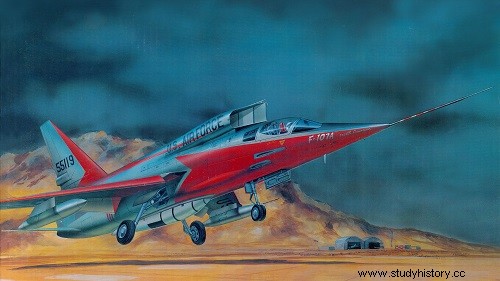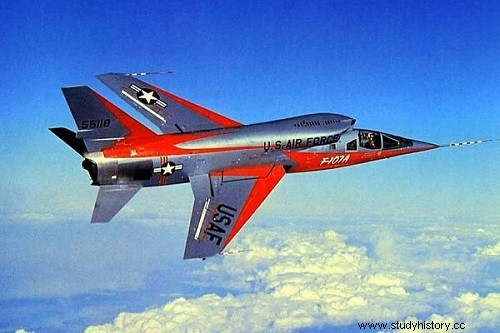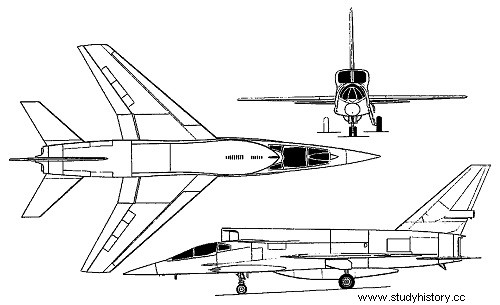
The North American YF-107 Ultra Saber is a 1950s American prototype fighter aircraft developed from the F-100 Super Sabre2. Built in only three copies, it served in particular within the National Advisory Committee for Aeronautics.
Development
Developed on its own funds2 by North American from 1953 to be able to supply a fighter-bomber to the US Air Force, the YF-107 Ultra Saber was first known under the manufacturer designation NAA-21. From the outset, the aircraft presented a surprising architecture3 with its turbojet engine installed in the fuselage upper surface position.
Its engine was provided by a Pratt &Whitney J75-P9, a reactor of the same family as that fitted to the Convair F-106 Delta Dart. Its particular installation forced the engineers and designers of the aircraft manufacturer to review the principles of laminar flow in order to create no obstacle before the air intake, and in particular at the level of the nose of the aircraft. The cockpit bubble was also revised. The F-100's in-flight refueling boom was missing.
For the rest, the aircraft was in the form of a monoplane with a low swept wing, single-engine metal construction. It had a retractable tricycle landing gear with non-keeled moving legs. Its armament consisted of four fixed 20 mm caliber guns installed two by two on either side of the fuselage at cockpit level. An external bomb load of 4,500 kg could be carried. Initially the Ultra Saber was not intended to be refueled in flight.

Originally known as the F-100B, three preproduction aircraft were ordered in 1954. The US Air Force took a close interest in this aircraft which had the quality of combining the already known cockpit of the Super Saber with innovative technology. However, opposed to the Republic YF-105, the aircraft no longer aroused the interest of American military officials, who chose the Thunderchief.
In service
After being flight tested by the US Air Force, the aircraft had a "second life" with NACA, which used it as an advanced training aircraft in the development of the North American X-research aircraft. 15. Retired from service in November 1958, they ended their careers under the colors of NASA.
Users
United States
US Air Force, for testing purposes only.
National Advisory Committee for Aeronautics.
National Aeronautics and Space Administration.
Versions &designations
NAA-211:Original designation given to the program by the aircraft manufacturer North American Aviation.
NAA-212:Final designation3 given to the program by the aircraft manufacturer North American Aviation.
F-100B:Original designation given to the program by the US Air Force.
YF-107:Final designation given to the program by the US Air Force, NACA then NASA.
F-107A:Temporary designation7 given to the first pre-production aircraft given by the aircraft manufacturer North American Aviation and by NASA.
Surname
Although officially designated Ultra Saber, the plane was nicknamed Super Super Saber by its detractors2, so much was its resemblance to the F-100.

Preserved planes
At the beginning of 2013 two North American F-107A Ultra Sabers were preserved in American aeronautical museums:
The YF-107A Ultra Saber, serial number 55-5118 at the Pima Air and Space Museum8 in Arizona.
The YF-107A Ultra Saber, serial number 55 -5119 at the National Museum of the United States Air Force9 in Ohio.
Constructor North American Aviation
Role Fighter aircraft prototype.
Status Removed from service.
First flight September 10, 1956
Date of withdrawal November 1958
Number built Three copies.
Crew A pilot.
Motorisation :1Pratt &Whitney J75-P9 engine
Type Turbojet
Unit thrust 7,800 kgp without afterburner or 11,113 kgp with afterburner.

Dimensions
Wingspan 11.15 m
Length 18.85 m
Height 5.89 m
Wing area 35.00 m2
Masses
Empty 10,295 kg
Maximum 18,841kg
Performance
Maximum speed 1,4321 km/h
Ceiling 16,220 m
Ascent rate 12,180 m/min
Range of action 3,885 km
Wing load 516 kg/m2
Thrust to weight ratio 0.62
Armament
Internal 4 x 20 mm fixed cannons.
External 4,500 kg of bombs
